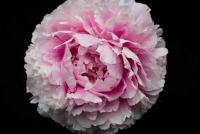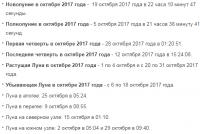Astrology is our friend! Pepper picks on the lunar calendar: when can be transplanted, which days are favorable
Most favorable days for sowing pepper seedlings on the moon sowing calendar 2016: January 15-16, February 11-12, March 9 and 10. If you do not have time to plant the pepper on these days, then you can still plant the seedlings on January 17-20, February 13-16, March 11-13, and March 16-17.
AT middle lane Russia and in the Moscow region pepper is grown only through seedlings. Seeds for seedlings are sown in late February - early March.
In the south of Russia and in Ukraine, the dates of sowing the pepper are shifted a month earlier: the pepper is planted on the seedlings already in the middle of January - in the beginning of February.
Pepper seedlings are sown in seedlings in the northern regions in late February - early March. In early terms - at the end of February - they sow pepper for growing seedlings with picks, as shown in our master class Growing pepper seedlings at home. If you sow pepper in cassettes or peat tablets and grow seedlings without picking, then optimal time sowing - from 1 to 10 March. For an example, see our master class Planting pepper seeds for seedlings in peat tablets.
At the same time, in the northern regions of Russia, in the Urals and in Siberia, it is preferable to plant early and early ripe varietieswho have time to mature in the condition of a short northern summer. It is better to plant undersized varieties that do not require garters and formation. The most capricious varieties of foreign selection, so choose zoned varieties.
According to the lunar sowing calendar best time for sowing pepper to seedlings when the Moon, which is in the first phase, is affected by the signs: Scorpio, Libra, Sagittarius or Aries. In January 2016, such days will be - 15-16 numbers, in February - 11-12, in March - 9 and 10.
If you do not have time to plant the pepper on these days, you can still plant the seedlings on January 17-20, February 13-16, 11-13, March 16-17, 2016.
Features of growing seedlings of pepper
When sown with seedlings, seedlings emerge at 5-6 days, dry - at 8-15 days.
The place where the seedlings of pepper are contained should be very bright, it is advisable to choose a south window. On a poorly lit window in February and March, seedlings are desirable to illuminate.
The temperature of the content of pepper seedlings about + 20 ° C, so as not to stretch. Increased temperature of the pepper is needed only for germination. At a lower temperature (of the order of +12 ... + 15 ° C), there is a delay in the growth of pepper seedlings, and at temperatures below + 5 ° C, the pepper stops growing. Poor effects on day and night temperatures are also bad. 15-20 days after the emergence of the seedlings of pepper, as a rule, dive.
For a picking in 2016 it is better to choose favorable lunar days: 7, February 20-21; 3, 6, March 18-19; 2-3, April 29-30.
Lunar Seedling Pickup
Water the pepper seedlings with water at room temperature or slightly warmed (+25 ... + 30 ° С). The roots that have become bare after irrigation should be lightly covered with soil. Put young growing plants closer to the window, and on sunny days you can keep them on the glazed balcony.
As soon as the third true leaf is formed in the seedlings of the pepper (15-20 days after the emergence of shoots), pick out the seedlings in separate containers.
In the middle lane, seedlings of pepper are planted in the ground at the age of 8-10 weeks, when frosts are passed. As a rule, in the middle of May in a greenhouse or under film, in the middle of April - in a heated greenhouse. Pepper seedlings must be quenched in fresh air in order to move the plants to permanent place in the greenhouse and ground.
Pepper: we sow in the soil
Favorable days in 2016 to care for the seedlings of pepper in the lunar sowing calendar gardener
Watering pepper seedlings on any day, except: 15-16, February 25-26; 14-15, 23 and 24, with caution on March 9; April 10-11 and April 19-21;
Introduction of complex feeding for pepper seedlings: 5-7, 8-10, 14, February 22-24; March 1-4, 6, 28-31; April 1, 6, 24-30;
Treatments against pests and diseases of pepper seedlings: 3-6, 13, February 18-24; 2-4, 11-13, 18-19, 28-31 March; 1, 6, 8-9, 14-16, April 24-28.
January 10 and February 9 - one of the most successful days for buying seeds of peppers and tomatoes for a new planting season.
Pepper formation
Peppers do not like to pinching: they stop growing, they can hurt for a while after pinching. Therefore, experts recommend choosing standard varieties that grow without forming. And only if you need to intensively use the greenhouse, its entire volume, then take tall peppers, which lead to 2 stalks - on each of several "floors" of the crop. This is more promising for areas with a long summer - the pepper is very thermophilic. Then remove the corona flower and then the stepchildren, leaving only the fork of the main stem. The pattern of forming varieties may differ. If the description of the variety does not say that it needs to be formed, but do not touch it better.
Lunar pepper seedlings
Can I immediately put the pepper in a separate pot
You can plant peppers at once in a separate peat pot of such a size that the roots of the seedling could soon master the entire volume of the earthy coma. Otherwise, the soil may sour, and the roots will be damaged by root rot. Pepper is one of those crops that are particularly susceptible to it. This technology is widely used in industrial conditions and in large greenhouses where it is possible to maintain a certain temperature and humidity, often watering and little by little, avoiding dryness and over-wetting of the earthy clod.
Pepper is one of the most popular crops that can be found in almost every garden. The fragrant fruit of the plant is rich in vitamins and minerals that have a positive effect on the human body. However, to grow strong seedlings, you need to take into account a number of factors, such as lighting, temperature, processing planting material and much more. When and how is planting pepper for seedlings in 2017 - in our article.
Lunar calendar seedlings pepper: better days for sowing
Even in ancient times, our ancestors paid attention to the fact that the Moon has a different impact on the growth and development of terrestrial plants. To get a bountiful harvest of crops, it is necessary to clarify the terms of planting peppers for seedlings in the gardener's gardener's calendar, which is made up taking into account all the lunar phases.
Favorable days for sowing pepper to seedlings:
- february: 1–6, 24, 27–29;
- march: 1–5, 26–29, 31;
- april: 1, 4, 5, 23–29.
Seedling growing technology
So, what pepper to plant on seedlings? The choice of plant varieties for planting should be based not only on personal preferences. It is necessary to take into account the climatic conditions in the region, because in the future the grown seedlings will grow in the soil. The best breeding varieties of pepper are Red Giant, Anastasia, Tusk, Alba, Belozerka, Shepherd, Sunny, Veronica, as well as many F1 hybrids, such as Quadri, Amika, Raphael, Tamina and Rubik.
Preparation of planting material pepper
After you decide on a variety and when to plant peppers for seedlings in 2017, you can proceed to presowing treatment of seeds.
First you need to sort out the material for planting and select the damaged and seemingly weak units. The next event is disinfection. It is necessary in order to protect plants from infection by various diseases. Consider the common methods of seed treatment:
- soak future seedlings in a weakly concentrated solution of potassium permanganate for 20-25 minutes and then rinse with plain water;
- soak the pepper grains in a gauze bag in the fungicides Vitaros or Fitosporin-M (the dosage is indicated by the manufacturer on the package);
- also good results are shown by soaking the material for 10-12 hours in the growth biostimulator Epin.
Then the seeds need to germinate. To do this, they should be placed between two wet wipes or layers of gauze and put in a warm room for 1–2 weeks (23–25 ºС). It is important to ensure that the fabric is constantly wet.
How to prepare a substrate for pepper?
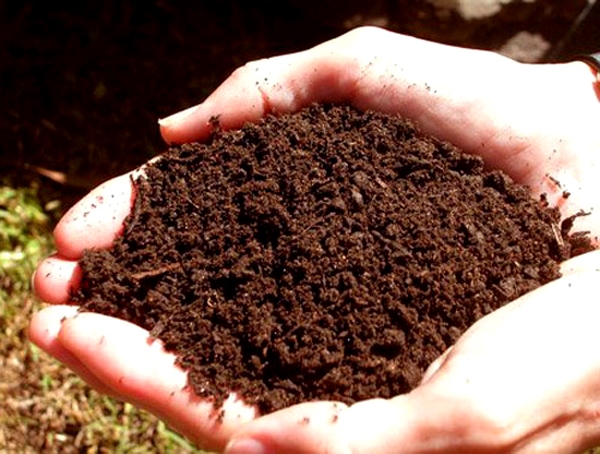 Growing pepper seedlings is impossible without a special soil mixture. You can buy it in the nearest agro shop or cook it yourself. Not only an experienced vegetable grower, but also a beginner can do this. To do this, mix the following components: 1 part of washed sand, 2 parts of rotted compost or humus and peat. The resulting composition must be treated with steam to protect against weeds and fungal diseases.
Growing pepper seedlings is impossible without a special soil mixture. You can buy it in the nearest agro shop or cook it yourself. Not only an experienced vegetable grower, but also a beginner can do this. To do this, mix the following components: 1 part of washed sand, 2 parts of rotted compost or humus and peat. The resulting composition must be treated with steam to protect against weeds and fungal diseases.
We sow pepper on seedlings according to the lunar calendar
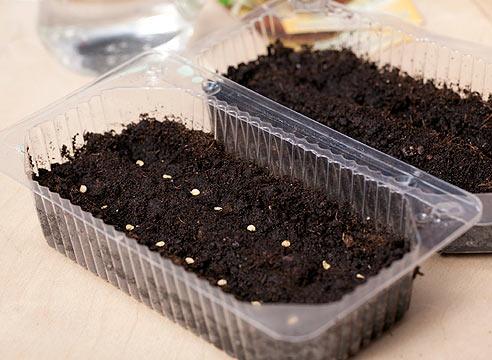 Planting containers before sowing must be disinfected with a light solution of potassium permanganate. Next, they need to be filled with the substrate and carefully spread the seeds of pepper on the surface with an interval of 1.5–2 cm - this is the optimal distance, if it is reduced, then the grown seedlings will start to create a shadow for each other. Next, you need to sprinkle the seedlings with earth, lightly pour it over with water, but only gently so that they are not washed off with water or use a spray gun, and cover the planting with a transparent film that will slow down the process of evaporation of the liquid.
Planting containers before sowing must be disinfected with a light solution of potassium permanganate. Next, they need to be filled with the substrate and carefully spread the seeds of pepper on the surface with an interval of 1.5–2 cm - this is the optimal distance, if it is reduced, then the grown seedlings will start to create a shadow for each other. Next, you need to sprinkle the seedlings with earth, lightly pour it over with water, but only gently so that they are not washed off with water or use a spray gun, and cover the planting with a transparent film that will slow down the process of evaporation of the liquid.
Pepper seedlings pick
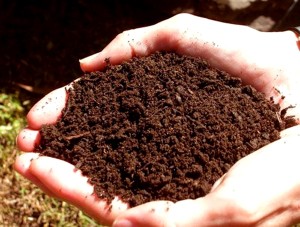 It is possible to transplant plants from boxes into individual peat or plastic containers after 2 real, green leaflets are formed on them. The second option is to carry out a pick of the seedlings in the cotyledon stage; there is an opinion that during this period they tolerate the procedure more easily. But this method is recommended to use only when cultivating seedlings in large greenhouses.
It is possible to transplant plants from boxes into individual peat or plastic containers after 2 real, green leaflets are formed on them. The second option is to carry out a pick of the seedlings in the cotyledon stage; there is an opinion that during this period they tolerate the procedure more easily. But this method is recommended to use only when cultivating seedlings in large greenhouses.
Before picking, it is necessary to pour the substrate well and wait for the moment when water will flow into the pallets of the containers. Pepper develops rather slowly, so the sprouts need to be transplanted in a tank of 100–150 g. Plant roots will be spacious, they will be able to quickly master the new soil and will be less susceptible to infection with rot. Consider the appropriate days for picking pepper seedlings:
- february: 7, 20, 21;
- march: 3, 6, 18, 19;
- april: 2, 3, 29, 30.
The temperature of the substrate should not be below 15 ° C, and at 13 ° C the growth of seedlings stops altogether.
- plant is thermophilic and requires careful treatment. Currently get good harvest Pepper can be in almost any region, while earlier only the southern regions could be proud of the rich harvest. All thanks to the huge selection of greenhouses, allowing to maintain a favorable temperature. However, the creation of good conditions is not enough, great importance is given to compliance with the recommendations relating to pepper picks.
Pepper does not always tolerate a picking, because these plants react badly to any manipulations with the roots. Pepper seeds are best planted in separate pots, but not all gardeners have such an opportunity. That is why the seeds are sown in one pot, then dive.
When they begin to dive seedlings?
Seeds planted in February will have from 4 to 6 leaves by mid-March. It was at this time that the struggle of plants for a place in the sun begins, and this indicates that the plants need a pick.
- the ideal time for seating peppers, but still the main criterion for determining when a plant needs to dive, is the number of leaves that appeared on the seedlings. Take note of this.
Proper picking of pepper seedlings
Before transplanting the plants, the soil is thoroughly moistened so that damage to the root system is minimal. Peat pots - the best packaging for picking seedlings. Cups made of peat, well preserve the roots of the plant, because you can plant seedlings in open ground together with pots. In addition, they do not contain substances harmful to plants. For picks, pots of at least 0.5 l are used. You can also plant plants in plastic cups.
Pots or cups need to be filled with primer. In the center of the compacted and slightly moistened soil a depression is made into which the seedling is very carefully placed along with the earthy clod. It is not recommended to shorten the roots when transplanting pepper. The central root should be placed in the recess so that it will not be bent anywhere. Cotyledon leaves should be at a distance of 1-2 centimeters from the surface of the earth. Then the soil is crimped around the transplanted seedling. After that, the earth is watered with warm water with the addition of the NV-101 biostimulants.
After picking for several days, you need to observe how seedlings get accustomed. When the height of the seedlings begins to increase, and the leaves - close together with neighboring plants, the pots must be moved. So seedlings will get enough air and light.
Departure after picking
For normal development, seedlings need to be fed. The first dressing can be carried out 14 days after the picking. For this, organic or any complex fertilizers are suitable. In well-growing plants, the crown should be light green in color, and the main leaves should be dark green.
If the pickling of the seedlings is carried out correctly and proper care is provided, then you, like many gardeners, will enjoy a rich harvest of this wonderful, albeit whimsical culture.
Breeding bell peppers - the occupation is interesting, but difficult, young saplings are quite capricious and require careful and careful care.
The roots of young plants are gentle, very sensitive to the transplant.
In contact with
- Lunar calendar and picks
- Useful materials
Lunar calendar and picks
REFERENCE! A pick is the distribution of seedlings from the total capacity into separate containers so that they do not shade each other during growth, and in order to avoid weaving of the roots.
The procedure is carried out after the appearance of the first or second true leaflet on the germ. Many experienced gardeners dive peppers, focusing on the lunar calendar. The effects of the phases of the moon are approximately the same on all organisms containing water, including plants.
- New moon - the phase of the moon, unfavorable for the growth and development of plants, all life-giving moisture accumulates in the roots. At this time it is better to refrain from transplanting.
- Waxing Crescent accompanied by active growth and prosperity, all nectar moves from the root system up the stalks to the leaves and flowers. This is the most appropriate time for the sweet pepper dive procedure. Even in case of damage root system will not suffer much, a high probability that the seedling will survive.
- Next comes the full moon - This is the time when all food is accumulated in the upper part of the plants - in the leaves and buds. But very soon all the liquid will begin to move back to the roots. Full moon, like the new moon - this is the period of suspension of all work on the landings and transplants.
- The fourth stage of the moon - decreasing. The life-giving juices of vegetable crops sink deep into the roots and accumulate there. Nothing bad will happen if you make a pick at this interval. This is a neutral stage for transplanting Bulgarian pepper.
In addition to these four positions of the moon, an indicator such as the sign of the zodiac, in which it is at that moment, affects the process of earthwork. There are more fertile signs, not at all fertile and neutral. Each of them affects a particular garden activity in its own way. Dive days are suitable when the moon is in Taurus, Libra, Scorpio.
The most unfavorable symbols for this procedure:
- Fish are considered to be a fertile symbol, but it is absolutely not suitable for picking.
- Refrain from this type of work is needed on the day of Sagittarius, Aries, Gemini and Virgo.
Usually they start sowing peppers in February, and by March he will have 2-3 true leaves. This stage of growth is most suitable for diving.
ATTENTION! In order for the operation to take place painlessly for young shoots, it is necessary to water them abundantly in 24 hours. On the day of transplanting it is better not to water the sprouts. So it will be easier to separate the roots without damaging them.
 It is necessary to approach the process of transplantation very carefully.
It is necessary to approach the process of transplantation very carefully.
- First, prepare the soil in which we will place our peppers. Most suitable soil based on peat and humus, it is advisable to add sand and field soil so that the soil is more friable.
- Capacities for seedlings must be high, then the root system will be stronger and grow well. At the bottom you need to pierce a few holes so that the earth does not acid. Next, pour the soil mixture.
- In the ground we press a small depression. A dive is made to the same depth that was originally when sowing; you do not need to plant deeper. In a dimple pour some water.
- Getting to the most important thing - transplanting sprouts. Carefully undermine the germ with an improvised tool and take it out, holding it by the stem.
Read more about how the picking is done in the article.
IMPORTANT! Pinch off the main root, as is done in tomatoes and other vegetable crops, not necessary. Solanaceae do not tolerate such manipulation and may even die. Just put the seedling in the prepared hole, then sprinkle it with earth, slightly compacting it.
After all the manipulations, it is desirable to place the seedlings in the same place where they were before. Then they adapt for a couple of days. The first two days you need to protect the peppers from hitting a bright sunny color.
Before conducting a picking, you need to check with the lunar calendar to select the most appropriate dates and exclude adverse ones.
Lunar calendar for picking peppers for March
Most favorable days for picking- March 2, 3, 16 and 17. Unwanted days - 1, 4, 5, 18, 21, 25, 26, 28, 29, 30 March.
The remaining days are neutral for the work of picking a sweet pepper.
REFERENCE! Learn about the different methods of growing peppers: in peat pots or tablets, in open ground and without picking, and even on toilet paper. Learn the cunning method of planting in a snail, as well as what diseases and pests can attack your seedlings?
Useful materials
Read other articles on growing seedlings for peppers and their further care:
- Proper cultivation of seeds and whether to soak them before sowing?
- How to grow black pepper peas, chili or bitter at home?
- What are growth promoters and how to use them?
- The main reasons why the leaves are twisted at the shoots, the seedlings fall or are pulled out, and also why the shoots die?
- Terms of planting in the regions of Russia and especially the cultivation in the Urals, Siberia and Moscow region.
- Learn yeast based fertilizer recipes.
- Learn the rules of planting Bulgarian and hot peppers.
- The timing of the first shoots and in what cases need additional illumination of seedlings?
When picking a sweet pepper, it is very important to take into account all the nuances and peculiarities of this rather whimsical solanaceous culture, as well as to choose the right time for such a complicated operation according to the Lunar calendar. If you find the right balance between these factors, you get a great harvest!
Sweet pepper is grown almost all gardeners. A great harvest of peppers can be obtained only with proper care and knowledge of some agrotechnical tricks. Grown in a greenhouse, sweet pepper is no different in taste and yield from its southern counterparts, if you know how to dive pepper and care for it. In this article I will share with you the technique of pepper picking and some other tricks of the poet culture.
Pepper picking is a complicated procedure. Of course, it is difficult not for you, but for the plants themselves. The fact is that pepper reacts very negatively to manipulation of its roots, and if it is easier to say, it does not like when the roots are disturbed. The most correct for such a delicate plant as pepper, would be planting one seed in a separate pot. Then the question of diving would be irrelevant, but not every gardener can afford such a crop. More often, the seeds of pepper are sown in one bowl, and then they are engaged in picking.
Is it possible not to dive the peppers?
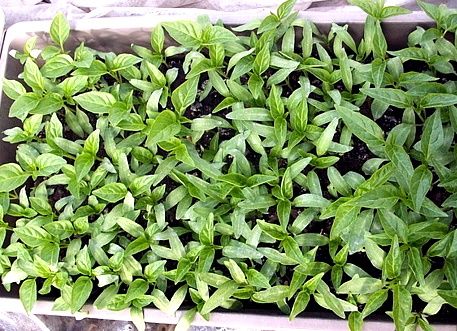
If our peppers are so sissy, is it better not to swoop them? Let them grow in one pot in a handful. It turns out that pepper culture is not only delicate, but also "harmful." If only the leaves begin to shade each other - the growth and development of plants slows down, the seedlings are drawn out and you will not see the perfect harvest. Therefore, we have to dive the peppers, each plant in a separate pot.
When do you need to dive peppers?
As we remember, we must sow the seeds of peppers early - in February. Only with early sowing can a gardener be able to reap a good crop, since the growing season of the pepper plants is longer than that of a tomato.
Proceeding from the fact that by the middle of March, the seeds of pepper sown by us in February already gave 4-6 leaflets and began to compete in a bowl for a place under the sun - it’s time to start picking.
So, the best time to dive is March. Look at the leaves of your seedlings. If they are 4 or more, feel free to start seating them.
Pots, breeding grounds and other containers for pepper seedlings

We have a bunch of little peppers that need to be seated. Now take care of the packaging for seedlings. Each pepper has its own box; they do not tolerate cohabitation in one bowl. Gardeners say that liter tetra packs (Tetra Pak) are the most convenient for seedlings of pepper - these are square boxes in which they sell juice, milk, and kefir.
This container is convenient because first of all the volume of the box with the trimmed tip will be optimal for the development of the roots up to the time the seedlings are planted in the ground. Secondly such packages are lightweight and waterproof.
Remember that in the boxes you must make a drain hole.
AND third - boxes are square and easy to install on windowsills and in boxes during transportation.
Before filling with soil mixture, the packages must be rinsed well and a hole must be made in the bottom so that the excess water from irrigation does not stagnate.
If tetra packs are not your option, then choose pots for seedlings with a sufficiently large volume, as our peppers grow in these dishes until they land in the ground.
Dive pepper seedlings
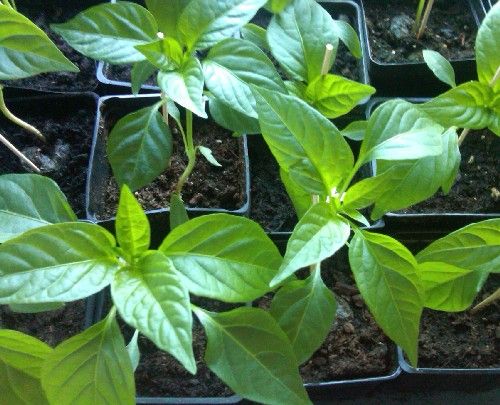
A day or two before transplanting, we don’t water the pepper seedlings. This will make it easier to separate the plants if they grow crowded together in the same pot. We pack bags or pots in prepared soil into which we will dive the pepper. Gently hooking with a spatula, take out the seedlings from the bowl.
It is easiest to repot the pepper if the seeds are sown in plastic soft cassettes.
You can often find a recommendation for pinching the root tip in pepper plants, however, if the roots of the seedlings are heavily woven, then finding the main root can be difficult. I think if you don’t pinch the spine, then nothing terrible will happen.
Each pepper is carefully transplanted into a separate package and watered. Slightly seal the ground around the pepper (not overdoing it).
Does the pepper seedlings deepen?
Often, gardeners argue about whether it is necessary to deepen seedlings of peppers to cotyledon leaves when they pick them up or not. I think that you should not bury pepper. The thing is that it is us, gardeners, who want to shove the plants deeper so that the seedlings are not stretched out. But pepper - this is not a tomato. It does not work out additional roots on the stem, but the plant that is too deeply buried can definitely rot.
Where to put the pickled pepper seedlings
When all the peppers are picked, you need to put the seedlings in a warm place (on the windowsill or table), but lightly sweat from direct sunlight. The first two days for seedlings with disturbed roots are the most difficult. You may even notice how the plants have gotten down, but do not be alarmed; if you did everything correctly, the peppers will restore turgor and grow well.
Immediately after the picking, you will see that the seedlings of pepper are slightly suspended in growth. Do not worry - this is normal. The roots of the pepper simply occupy new territory and increase the "lost" roots during the transplant.

I want to pay special attention to where the sprinkled pepper seedlings will continue to grow. If the seedlings grow on the same window sill, where they grew before the pick, then the plants should not have any special stress. But, if after a picking you transfer the seedlings to a heated greenhouse, then there is a completely different illumination, temperature and microclimate - so prepare for the fact that the plants will adapt longer.
Let the picking of your peppers succeed!


